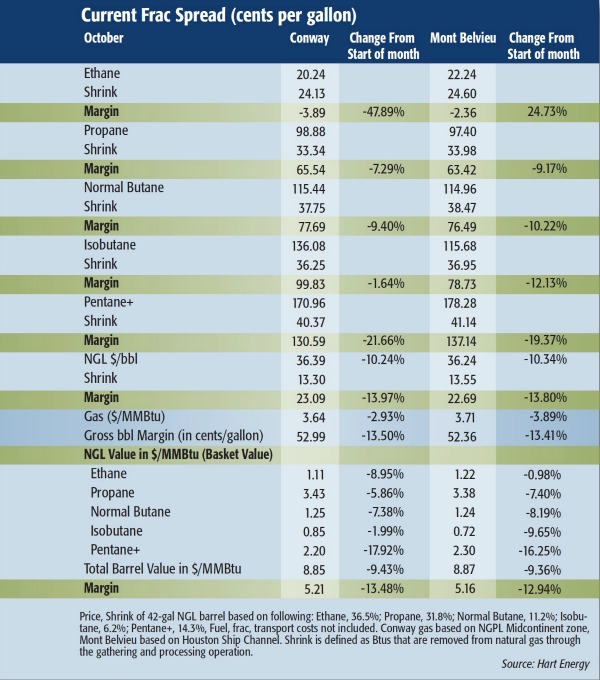NGL prices took a large downturn as they followed the downward trajectory of West Texas Intermediate (WTI) crude oil prices, which fell to their lowest levels in several years, just above $80 per barrel (bbl) by late October.
Not only has this price decrease hampered heavy NGL, it also has the potential to weaken the North American petrochemical industry’s price advantage compared to the rest of the world if naphtha becomes more economical than NGL as a feedstock.
While there is still some way to go before naphtha cracking would be on a level playing field with ethane, the steep crude price decrease the second week of October doesn’t put this scenario outside the realm of possibility.
There are several reasons for the depressed crude market: fears over the spread of the Ebola virus that could limit travel and result in depressed global economies, increased production out of the Middle East and decreased European and Asian demand.
The impact this decreased demand for crude had on the NGL market was swift as prices fell to their lowest levels in more than a year across the board at both the Conway, Kan., and Mont Belvieu, Texas, hubs. The largest downturn was for propane, which fell below the $1 per gallon (gal) threshold at both hubs.
The Mont Belvieu price fell 8% to 97 cents/gal, its lowest price since it was 96 cents/gal in July 2013, and the Conway price tumbled 9% to 99 cents/gal, its lowest price since it had the same value in August 2013.
Crude-propane relationship
While LPG exports have helped increase demand and value for U.S. propane, they have also helped to improve the relationship between crude and propane due to increased exposure to global price trends. This relationship helped undermine U.S. propane prices as global LPG prices were down from last month.
However, propane could be facing a steep price correction if heating demand doesn’t match the same levels as last year because inventory levels remain high. Indeed, the U.S. Energy Information Administration released its short-term energy outlook and stated Midwest propane inventories at the end of September were 15% greater than at the same time last year, which caused the agency to forecast significantly lower heating bills for Midwest homes this coming winter.
Ethane cracking capacity has been hampered by planned and unplanned turnarounds. While it was anticipated that several facilities will be back online by the beginning of November, at least three more plants will undergo turnarounds in fourthquarter 2014 and first-quarter 2015.

Frank Nieto can be reached at fnieto@hartenergy.com or 703-891-4807.
Recommended Reading
QatarEnergy Joins Joint Venture Offshore Namibia
2024-12-17 - QatarEnergy acquired a 27.5% stake in petroleum exploration license 90 offshore Namibia.
Shell Selects SLB for Deepwater Drilling Contracts
2025-01-08 - SLB will deliver the projects in the U.K. North Sea, Trinidad and Tobago and the Gulf of Mexico, among others regions, over the next three years.
Blackstone Buys NatGas Plant in ‘Data Center Valley’ for $1B
2025-01-24 - Ares Management’s Potomac Energy Center, sited in Virginia near more than 130 data centers, is expected to see “significant further growth,” Blackstone Energy Transition Partners said.
Liberty Energy, DC Grid to Collaborate on Turnkey Power Solutions
2025-01-08 - Liberty Energy’s power solutions and DC Grid’s direct current systems will offer rapidly deployed, scalable and sustainable power for data centers, among other uses.
BW LPG Takes Sixth VLGC Delivery from Avance Gas
2024-12-09 - The delivery of the BW Rigel vessel marks the sixth vessel delivered to BW from Avance Gas as part of the companies’ $1.5 billion deal for 12 very large gas carriers.
Comments
Add new comment
This conversation is moderated according to Hart Energy community rules. Please read the rules before joining the discussion. If you’re experiencing any technical problems, please contact our customer care team.





